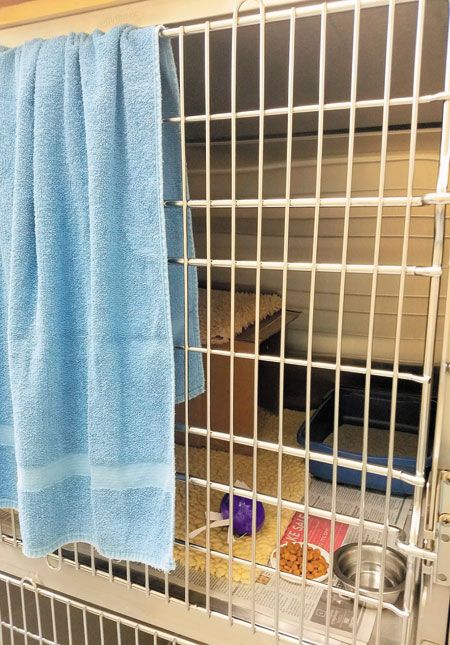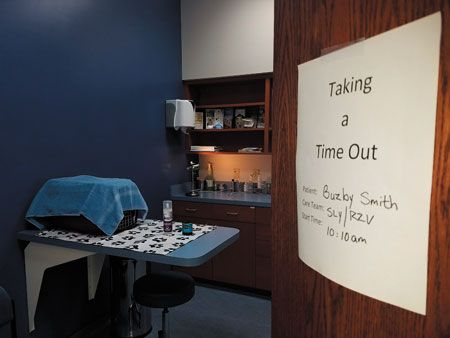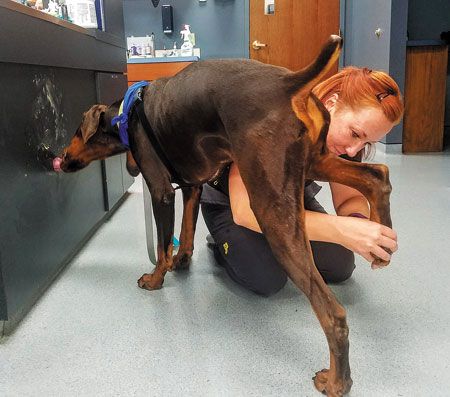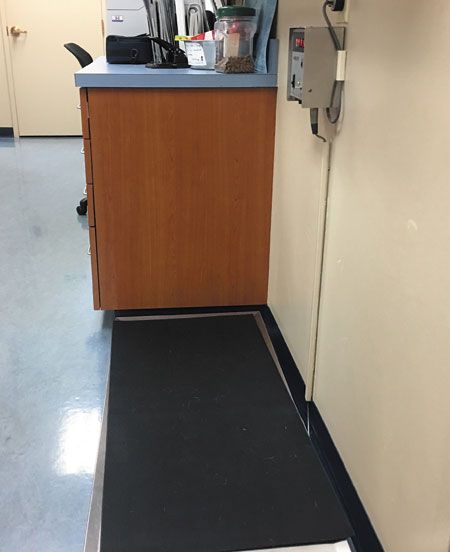4 tips for enriched hospital spaces
Consider these ideas to create enrichment areas for visiting pets in your veterinary practice.
Consider the following practical tips for adding enrichment throughout your hospital. (Also see "3 exam room enrichment tips" for ideas to make the exam experience more pleasant for pets.)
Enriched cat space

Image courtesy of Avery Animal HospitalCats tend to seek height and hiding when they feel stressed and afraid. Here's how to create a safe cage space for healing:
• Use a towel sprayed with Feliway pheromones to create a partial visual barrier for the door. This allows eating and elimination in privacy.
• Natural or low light is best.
• The hide box allows a choice.
• The fleece on top provides higher perch.
• Fleece flooring provides warmth and sound dampening of a steel cage.
• Small water bowls maximize space and a flat food dish to prevent whisker stimulation from small bowls.
• The puzzle feeder with kibble inside offers engagement.
Time out cat

Image courtesy of Avery Animal Hospital
Cats who arrive expressing fear and stress should be allotted time for sympathetic nervous system deactivation before handling. Here's how to create this quiet space:
• Choose a quiet room with low light to limit stimulation.
• Use a Feliway pheromone towel covering to calm and allow hiding.
• Place the carrier on the table to provide a sense of safety (height).
• Use an option like the iCalm music player for sound masking as well as relaxation.
• Place signage on door to inform team members and promote low-stress handling techniques to clients.
Nail trim cheese wall

Image courtesy of Avery Animal HospitalUse a vertical surface to smear creamy treats (such as cheese) for a hands-free delivery method during procedures. The dog is distracted, needs minimal restraint and associates a positive emotion with nail trimming. This method can also be used while a dog is wearing a basket muzzle. The bite risk is relieved so you can use minimal restraint.
Scale corner

Image courtesy of Avery Animal HospitalDon't struggle to convince the dog to walk into a corner to step onto a scale. This removes the perception of flight. Instead, change the view and the route to allow easy weigh-ins. It's also a good idea to create a treat trail scale. Approach the scale so the dog walks into the open space. Place treats in a trail for the dog to follow onto the scale. The dog gets rewarded every step of the way!
Sherrie Yuschak, RVT, VTS (behavior), CPDT-KA, is member-at-large of the Academy of Veterinary Behavior Technicians. She is also the owner of Better Behavior Solutions and a clinical behavioral technician at North Carolina State University's College of Veterinary Medicine.